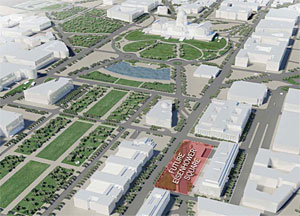In the firmament of U.S. presidents, Dwight D. Eisenhower may not be known for his star power. But the Washington, D.C., memorial planned for the 34th commander-in-chief will enjoy the talents of a marquee-name architect: Frank Gehry.

On March 31, after six months of sifting through 44 entries, the commission assigned to the job of creating the memorial announced it picked Gehry, a Pritzker winner, to design the four-acre site, which is located a block south of the National Mall. The $110 million project, which is part of the General Service Administration’s Design Excellence Program, is set for completion in 2014.
Gehry beat out three other finalists in the competition’s third and final stage: Krueck + Sexton Architects, from Chicago; PWP Landscape Architecture of Berkeley, California; and Rogers Marvel Architects of New York City. Because Gehry’s plan is preliminary and still requires input from the Eisenhower family and key D.C. agencies, details won’t be made public until the design is completed, according to the Dwight D. Eisenhower Memorial Commission, which is overseeing the project.
Proposals had to spell out how the site could be transformed into a public square and needed to include a canopy and 2,500 square feet of enclosed space for ranger stations, restrooms, and possibly a bookstore, according to Daniel Feil, FAIA, who is the commission’s executive architect. The scheme could feature a central focal point that pays tribute to an aspect of Eisenhower’s presidency, Feil adds, or more likely, standalone sections dedicated to various accomplishments of his multifaceted career. Yet unlike other tributes to presidents in Washington, the memorial may not include any statuary.
Gehry’s plan stood apart, according to Feil, because it emphasizes a significant amount of greenery for the mostly concrete and asphalt site, which is bisected diagonally by 11-lane-wide Maryland Avenue. In recent years, the site has served as a de facto parking lot.
“He understands that a civic space must have certain duality,” Feil says. “You want to appreciate it from the outside looking in, but when you’re inside, you want to focus on the message.”
Though quotations could adorn certain walls, whether carved in stone or mounted on plaques, signage will probably be minimal. In fact, visitors will probably learn more about the subject of the memorial from specially created Web video and audio files—a clip of an old Eisenhower speech, perhaps—beamed to a handheld device like, say, an iPhone. Under the competition’s guidelines, Gehry must design this electronic element, too.
The gist of that content, commission members say, will be to provide a more in-depth look at the legacy of Eisenhower, who was the Allied forces’ commanding general in Europe during World War II, and who later went on to head both NATO and Columbia University. Also, as president, Eisenhower created federal agencies focused on education, health, and air-travel safety that endure to this day; indeed, many are housed near his planned memorial, like the Department of Education, whose block-long building forms an edge of the site.
“This is a man whose life spanned two centuries during a period of tremendous change in American history,” says Carl Reddel, the commission’s executive director.
Despite his numerous, spread-out accomplishments, Eisenhower was unusually humble, a personality trait that attracted Gehry to the project, which stands to be his first completed commission in D.C. (Earlier this decade, a Gehry-designed wing for Washington’s Corcoran Gallery of Art was scuttled because of insufficent fundraising.)
“He wasn’t blustery and didn’t make big pronouncements,” Gehry says. “I feel a sense of kinship with how he did what he did.”
One thing that is unknown is whether Gehry will recommend closing the stretch of Maryland Avenue that cuts through the site. That decision could anger those who argue that the street should be improved, so it can function as a grand vehicular thoroughfare like Pennsylvania Avenue in accordance with the city’s 1902 McMillan master plan.
Also, Judy Scott Feldman, president of the National Coalition to Save Our Mall, a nine-year-old advocacy group, says she is concerned that memorial’s ranger stations and bathrooms could provide jarring visual notes as they do at the nearby National World War II Memorial. She adds, though: “We will have to wait and see what Gehry comes up with.”
* Disclosure: RECORD’s editor in chief, Robert Ivy, FAIA, was involved in the initial stages of judging.





Post a comment to this article
Report Abusive Comment